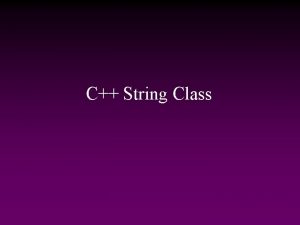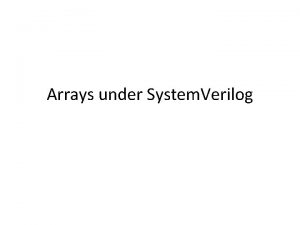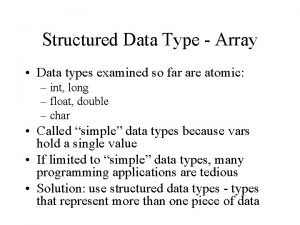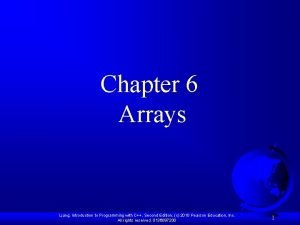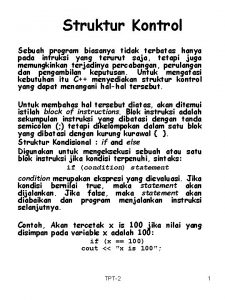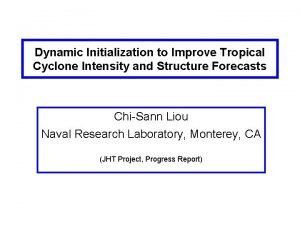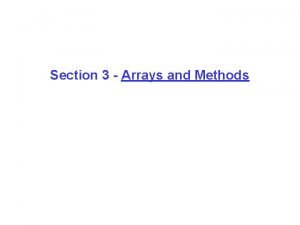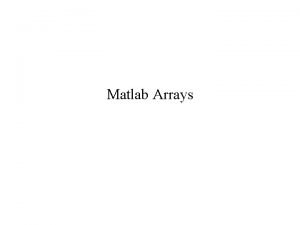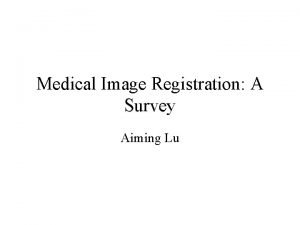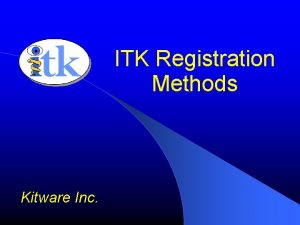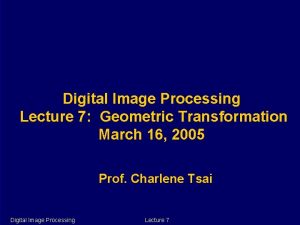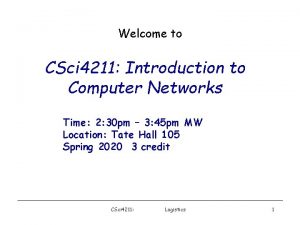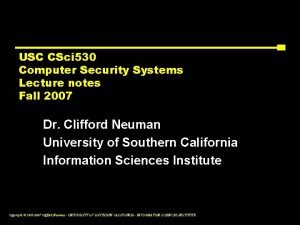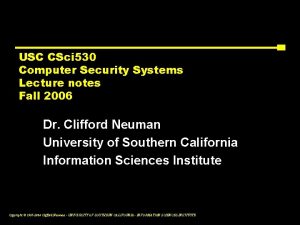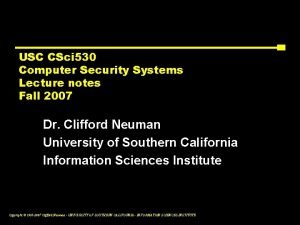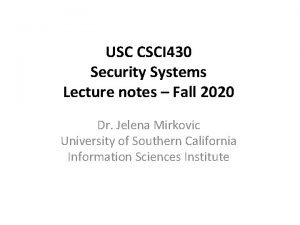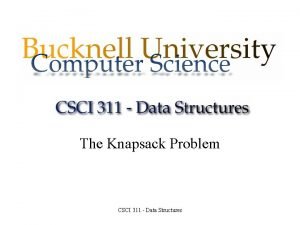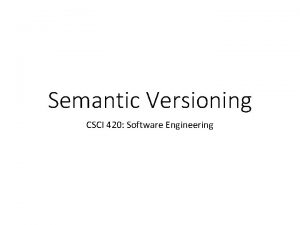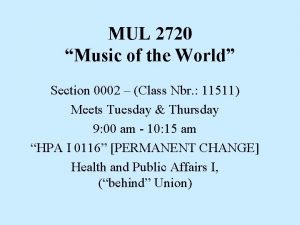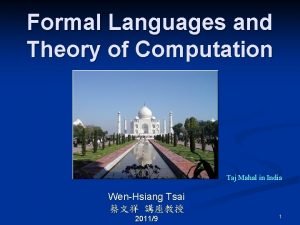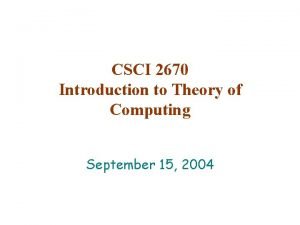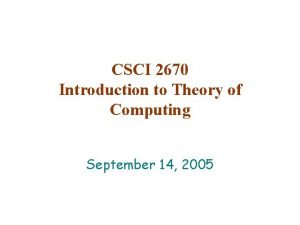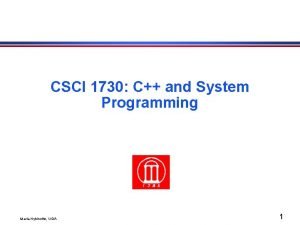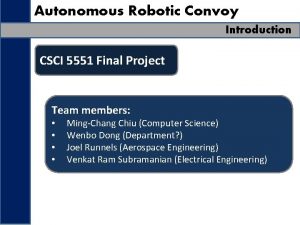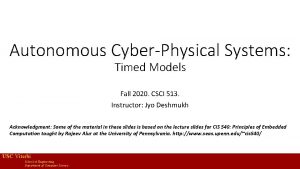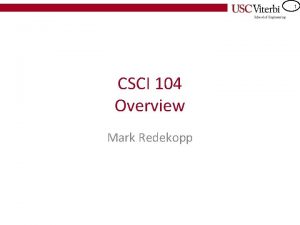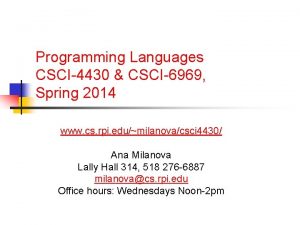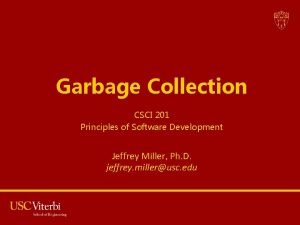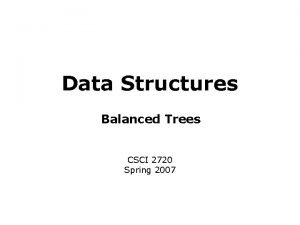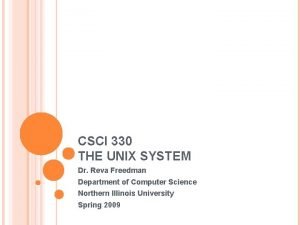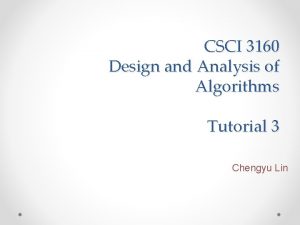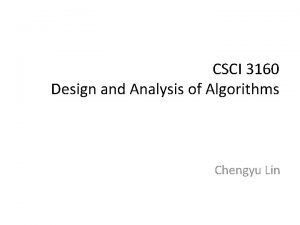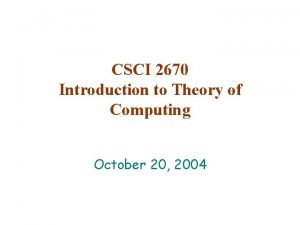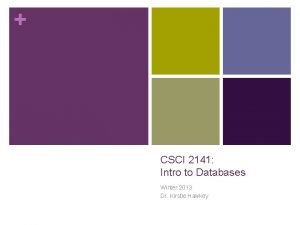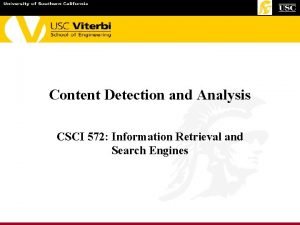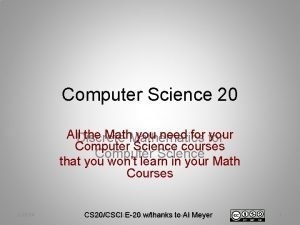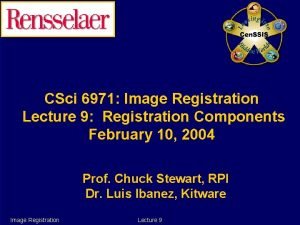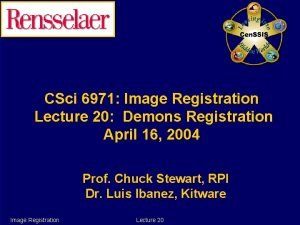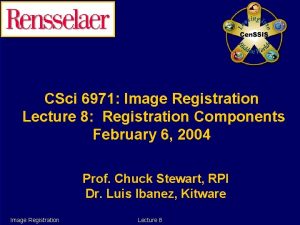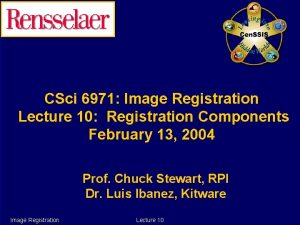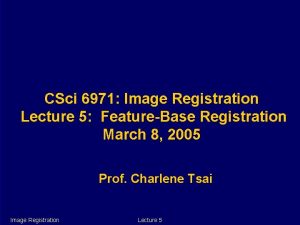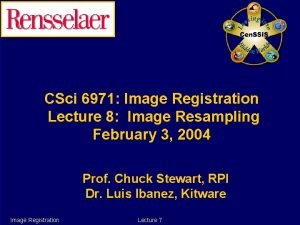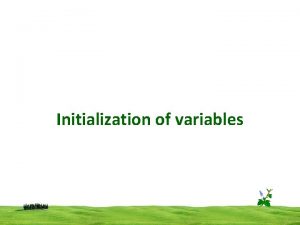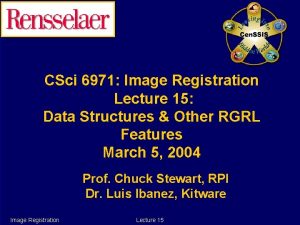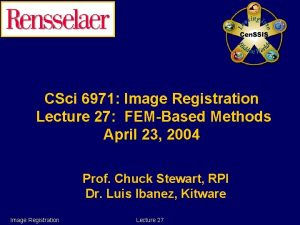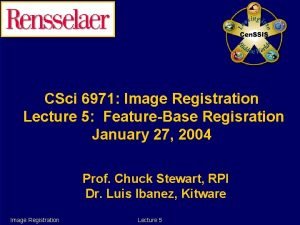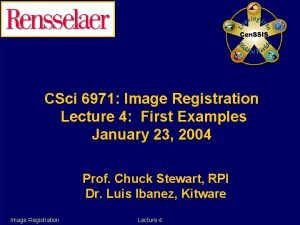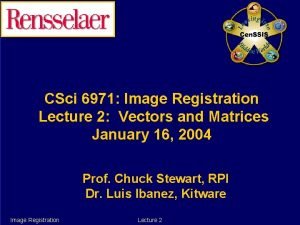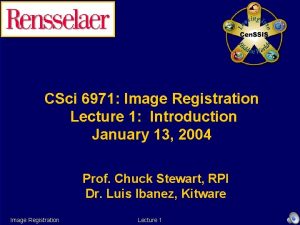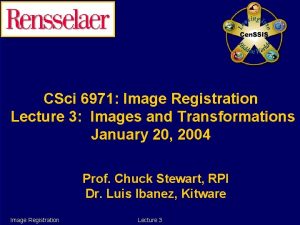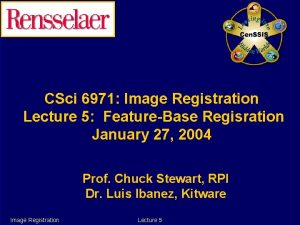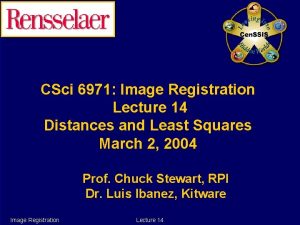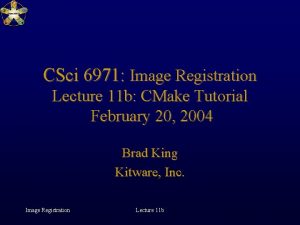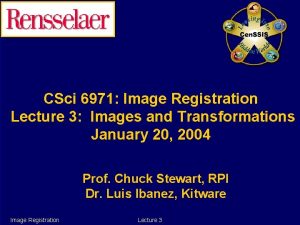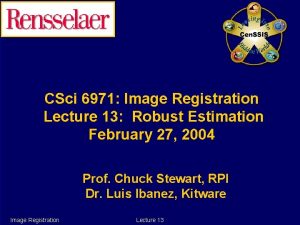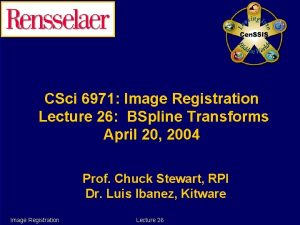CSci 6971 Image Registration Lecture 18 Initialization March








































- Slides: 40

CSci 6971: Image Registration Lecture 18: Initialization March 23, 2004 Prof. Chuck Stewart, RPI Dr. Luis Ibanez, Kitware Image Registration Lecture 18

Overview - Lectures 18 & 19 § Lecture 18: § Importance of initialization § Simple methods: § Sampling of parameter space § Moment-based methods § Least-squares estimation of rotation in 3 D § Lecture 19: § Invariants § Interest points and correspondences § Robust estimation based on random-sampling Image Registration Lecture 18 2

Motivation: Domain of Convergence § Most core registration algorithms, such as intensitybased gradient descent and ICP, have a narrow domain of convergence (“capture range”) § We saw this in Lectures 6 -10 on intensity-based registration § The following page repeats an earlier example using feature-based registration Image Registration Lecture 18 3

ICP - Correct Convergence Image Registration Lecture 18 4

ICP - Incorrect Convergence Image Registration Lecture 18 5

What Affects the Domain of Convergence? § Structural complexity: § Lots of similar blood vessels in retinal image § Smoothness of objective function § Small hitches in the objective function cause the minimization to become “stuck” § Flexibility of search technique § More flexible, adaptive searches have broader domains of convergence § Complexity of parameter space § More complicated transformations are more difficult to minimize Image Registration Lecture 18 6

Improving Domain of Convergence § Techniques § Multiresolution § Region-growing § Increasing order models § Adaptive search techniques § Multiple initial estimates Image Registration Lecture 18 7

Implications for Initialization § Without these techniques, initialization must be extremely good! § With them, initialization is still important § Many of the initialization techniques we’ll describe can or should be used in conjunction with one (or more) of the foregoing methods § In addressing a registration problem you need to think about: § Complexity of the problem (data, transformation, etc) § Capabilities of techniques available § Methods of initialization available § These all interact in designing the solution Image Registration Lecture 18 8

Onto Initialization Techniques… § Prior information / manual initialization § Sampling of parameter space § Moments § And Fourier methods § Invariants § Random-sampling of correspondences Image Registration Lecture 18 9

Prior Information / Manual Initialization § Registration starts from an approximately known position § Industrial inspection is a common example § The goal of registration is then high-precision “docking” of the part against a model § One must be careful to analyze the domain of convergence and the initial uncertainty in position to determine when this will work § In some applications, it is sufficient to manually “drag” one image on top of another § This is really a translation-based initialization Image Registration Lecture 18 10

Fiducials § Often used in image-guided surgery § Easily-detected markers (beads) are placed pre-operatively § Initial registration is based on the correspondence of these fiducials § This can be done manually or automatically § This initializes an automatic procedure for fine-resolution alignment of all image data http: //www. radiology. uiowa. edu/NEWS/IGS-infrastructure. html Image Registration Lecture 18 11

Sampling of Parameter Space § Applied at coarse resolutions and low-order transformations (esp. translation only) § Initialize by sampling a range of transformations established a priori § Sample spacing is based on the convergence properties of the algorithm: § Wider spacing of samples is possible when the algorithm has a broader domain of convergence § Assumes the registration algorithm is fast enough to allow testing of all samples § Imagine how many samples you could test if the registration algorithm required only a few milliseconds! § Imagine how few samples you could test if the registration algorithm required hours! Image Registration Lecture 18 12

Alignment Based on Moments § Used for aligning “point sets” such as range data sets § Applied before establishing correspondence § Based on first moments (center of mass) and second moments and low order transformations. § The details are described the next few slides § Related techniques can be applied to images, often by matching Fourier transformations: § Translations in the spatial domain become phase shifts in the frequency domain § Rotations in the spatial domain become rotations in the frequency domain § Scaling in the spatial domain corresponds to inverse scaling in the frequency domain Image Registration Lecture 18 13

Setting Up the Problem § Given two point sets § Our goal is to find the similarity transformation that best aligns the moments of the two point sets. § In particular we want to find § The rotation matrix R, t § The scale factor s, and § The translation vector t Image Registration Lecture 18 14

In Pictures Image Registration Lecture 18 15

Moments § The first moment is the center of mass Image Registration Lecture 18 16

Second Moments § Scatter matrix § Eigenvalue / eigenvector decomposition (Sp) § where li are the eigenvalues and the columns of Vp hold the corresponding eigenvectors: Image Registration Lecture 18 17

Effect of Rotation, Translation and Scale § Rotated points: § Center of the rotated data is the same as the rotated, scaled and translated center before rotation: Image Registration Lecture 18 18

Scatter Matrix § Rotated, scaled scatter matrix: Image Registration Lecture 18 19

Eigenvalues and Eigenvectors § Given an eigenvector vj of Sp and its rotation vj’ = Rvj: § Multiply both sides by s 2 R, and manipulate: § So, § Eigenvectors are rotated eigenvectors § Eigenvalues are multiplied by the square of the scale § Std deviations, the squareroots of the eigenvalues, increase only by the scale Image Registration Lecture 18 20

Using This in Registration § Goal: compute similarity transformation that best aligns the first and second moments § Assume the 2 nd moments (eigenvalues) are distinct § Procedure: § Center the data in each coordinate system § Compute the scatter matrices and their eigenvalues and eigenvectors § Using this, compute § Scaling and rotation § Then, translation Image Registration Lecture 18 21

Rotation § The rotation matrix should align the eigenvectors in order: § Manipulating: § As a result: Image Registration Lecture 18 22

Scale § Ratios of corresponding eigenvalues should determine the scale: § But, because of noise and modeling error the ratios will not be exact. § Hence, we switch to a least-squares formulation § Taking the derivative with respect to s 2, which we are treating at the variable here, we have: § Setting the result to 0 and solving yields Image Registration Lecture 18 23

Translation § Once we have the rotation and scale we can compute the translation based on the centers of mass: Image Registration Lecture 18 24

Comments § Calculations are straightforward, non-iterative and do not require correspondences: § Moments, first § Rotation and scale separately § Translation § Assumes the viewpoints of the two data sets coincide approximately § Can fail miserably for significantly differing viewpoints Image Registration Lecture 18 25

Lecture 18, Part 2 Image Registration Lecture 18 26

Image Registration Lecture 18 27

Lecture 18, Part 2: Estimating Rotations In 3 D § Goal: Given moving and fixed feature sets and correspondences between them, estimate the rigid transformation (no scaling at this point) between them § New challenge: orthonormal matrices in 3 d have 9 parameters and only 3 degrees of freedoms (Do. F) § The orthonormality of the rows and columns eliminates 6 Do. F § This is one example of constrained optimization, where the number of parameters and the degrees of freedom don’t match Image Registration Lecture 18 28

Rotation Matrices in 3 D § Formed in many ways. § Here we’ll consider rotations about 3 orthogonal axes: Image Registration Lecture 18 29

Composing § Composing rotations about the 3 axes, with rotation about z, then y, then x, yields the rotation matrix § Notes: § It is an easy, though tedious exercise to show that R is orthonormal § Changing the order of composition changes the resulting matrix R § Most importantly, it appears that estimating the parameters (angles) of the matrix will be extremely difficult in this form. Image Registration Lecture 18 30

Options § Different formulation: § Quaternions are popular § Angle-axis § Approximations: § Route we will take here § Perhaps better than quaternions for error projector matrices that yield non-Euclidean distances Image Registration Lecture 18 31

Small-Angle Approximation § First-order (small angle) Taylor series approximations: § Apply to R: Image Registration Lecture 18 32

Small-Angle Approximation § Eliminate 2 nd order and higher combined terms: § Discussion: § Simple, but no longer quite orthonormal § Can be viewed as the identity minus a skewsymmetric matrix, which is closely related to robotics formulations. Image Registration Lecture 18 33

Least-Squares Estimation § Rigid transformation distance error: § This has the same form as our other distance error terms, with X and r depending on the data and a being the unknown parameter vector. Image Registration Lecture 18 34

Least-Squares Estimation § Using the error projector we can estimate the parameter vector a in just the same way as we did for affine estimation § Note: we are not estimating the scale term here, which makes the problem easier. This is ok in cases, such as range data, where the scale is known. § What we need to worry about is undoing the effects of the small-angle approximation. In particular we need to § Make the estimated R orthonormal § Iteratively update R Image Registration Lecture 18 35

Making the Estimate Orthonormal § Inserting the estimated parameters into R § The matrix is NOT orthonormal. § Two solutions: § Put the estimated parameters (angles) back into the original matrix (with all of the sines and cosines) § Find the closest orthonormal matrix to R. § This is the option we apply. It is very simple. Image Registration Lecture 18 36

The Closest Orthonormal Matrix § It can be proved that the closest orthonormal matrix, in the Frobenius-norm sense is found by computing the SVD and setting the singular values to 0 § In other words, with § The closest orthonormal matrix is Image Registration Lecture 18 37

Iteratively Estimating R and t § § Given are initial estimates of R and t, the correspondences {(gk, fk)} and the error projectors Pk Do § Apply the current estimate to each original moving image feature: § Estimate rotation and translations, as just described above, based on the correspondences {(gk’, fk)}. § Convert the rotation to an orthonormal matrix. Call the results DR and Dt. § Update the estimates to R and t. In particular, because the transformation is now, the new estimates are § Until DR and Dt are sufficiently small (only a few iterations) Image Registration Lecture 18 38

Summary and Discussion § Small angle approximation leads to simple form of constraint that can be easily incorporated into a leastsquares formulation § Resulting matrix must be made orthonormal using the SVD § Estimation, for a fixed set of correspondences, becomes an iterative process § Anyone who wants to implement this for rgrl can do so as their programming project! Image Registration Lecture 18 39

Looking Ahead to Lecture 19 § Initialization based on § Matching of interest points § Random-sampling robust estimation Image Registration Lecture 18 40
 Anthem of poland
Anthem of poland Java string initialization
Java string initialization Verilog array indexing
Verilog array indexing Ymir character initialization
Ymir character initialization Types of array in c
Types of array in c C++ struct partial initialization
C++ struct partial initialization Initialization dan increase pada penggunaan for bersifat
Initialization dan increase pada penggunaan for bersifat Initialization
Initialization Bios initialization
Bios initialization C# multidimensional array initialization
C# multidimensional array initialization Matlab array initialize
Matlab array initialize 01:640:244 lecture notes - lecture 15: plat, idah, farad
01:640:244 lecture notes - lecture 15: plat, idah, farad A survey of medical image registration
A survey of medical image registration Itk registration tamilnadu
Itk registration tamilnadu Image processing lecture notes
Image processing lecture notes Fluorocein
Fluorocein Csci 4211
Csci 4211 Csci 530
Csci 530 Csci 530 security systems
Csci 530 security systems Csci 530 security systems
Csci 530 security systems Csci430
Csci430 Contoh knapsack problem
Contoh knapsack problem Major minor patch build
Major minor patch build Scott warfield ucf
Scott warfield ucf Csci 1951a
Csci 1951a Csci 2670
Csci 2670 Csci 2670
Csci 2670 Csci 1730 uga
Csci 1730 uga Csci 5551
Csci 5551 Csci 513 usc
Csci 513 usc Csci 104
Csci 104 Csci4430
Csci4430 Csci 201 usc
Csci 201 usc Csci 2720
Csci 2720 Reva freedman
Reva freedman Csci3160
Csci3160 Csci 3160
Csci 3160 Csci 2670
Csci 2670 Csci 2141
Csci 2141 Csci572
Csci572 Csci e-20
Csci e-20

